#》. worldbuilding
Explore tagged Tumblr posts
Text

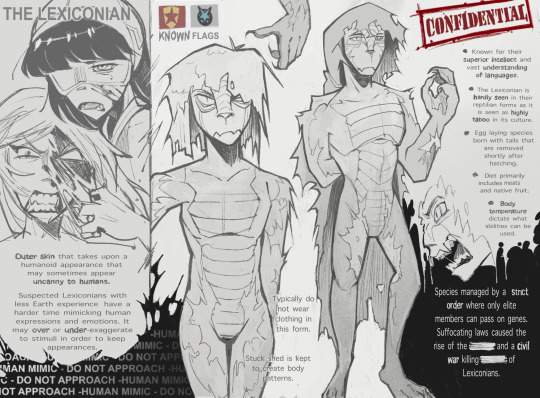
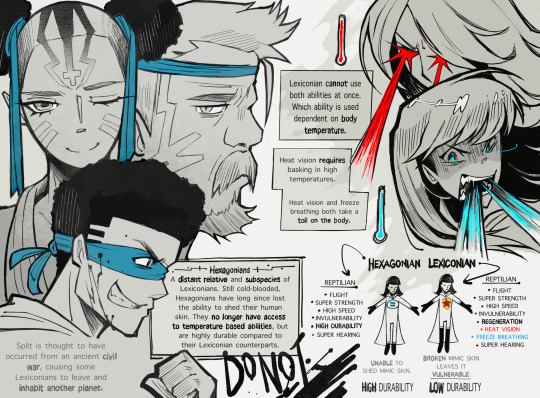
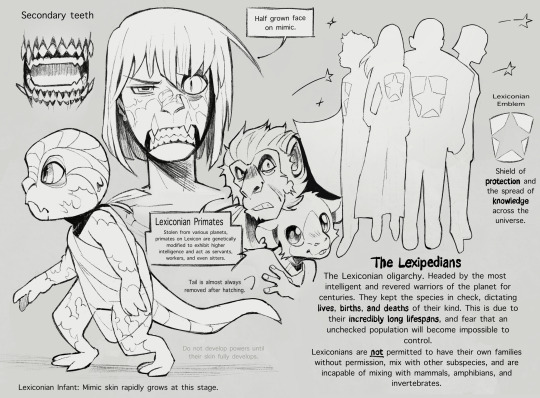
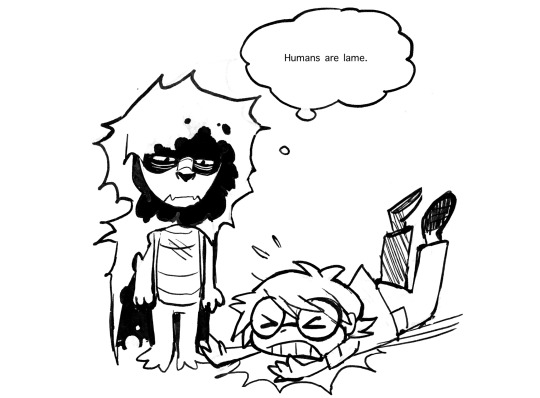


#wordgirl#final definition au#becky botsford#tobey mccallister#kid math#dr two brains#fanart#au#alternate universe#oc#digital art#comic#fancomic#webcomic#fanartist#worldbuilding#word girl#tobey mcallister iii#steven boxleitner#amazo guy#miss power
206 notes
·
View notes
Text

Various displays of affectionate behavior from various chenesht couples.
Fun fact! Chenesht 'kissing' doesn't involve the lips nearly as much as it looks like it does. The lips are pressed against the face of the receiver, and then the kisser's whiskers flit about the receiver's face in an affectionate manner to both give and receive pleasent sensory input. The lips are just an anchor point.
#arte#setting: sacred estuaries#SE chenesht#worldbuilding#xenobiology#speculative biology#specbio#original alien species#original alien character
155 notes
·
View notes
Note
ive no clue how much our choice of parents in the beginning is gonna matter other than flavour text but its still my favourite part of the story, and i want to do 3 different playthroughs. love each and everyone.
(Ohohohohoho it matters)
I'm really glad you like the parent choice because it's one of the first choices, and I feel like it's also one of the bigger ones. It really shapes the interior of the MC, and I feel like there are truly, at the core of the story, three MCs. The scholar, the warrior, and the performer.
Even when you make choices that are different from your choice of mentor, how the MC views situations has that undercurrent. And maybe in the distorted reflections the MC sees as the story continues and in the choices the MC makes, maybe there is still the person the mentors hoped the MC could become.
#interactive fiction#honor amongst thieves#if wip#game development#interactive novel#worldbuilding#hat if#mentors#mc customization
95 notes
·
View notes
Text
Imagination has been captured by the adventures of Normal Archeologist who has been meticulously dusting off pottery sherds for the past 48 hours straight because the Pain-Eating Brain Worm has rendered them incapable of feeling any kind of negative sensation like "hunger" out of a misguided desire to take away their pain. Time to write!
The archaeologist was holed up in a clearing in the woods, scraping dust from a twisted, organic-looking pottery sherd. He was buck naked and filthy, not that he seemed to mind. A hulking spective that looked vaguely like a human-sized sea slug slurped noisily on the back of his skull, drinking little silver lights. Neither looked up or acknowledged us as Ana and I stepped down into the clearing.
“Erishen?” I cautiously asked. “I’m with the orchard; your family’s worried about you.”
No response. I walked forwards, Ana matching me step for step. The hunched-over young man had a beatific smile on his face, squatting in the dirt and using a fine brush on the sherd. Every now and then he paused to take notes on a clipboard. He showed no sign of being aware of our approach.
I hesitantly tapped him on the shoulder—perhaps he was Deaf? The Orchard intel didn’t mention it, but the Orchard intel was just written by other workers like Ana and me. They could mess up and be incorrect.
So could I, apparently. If he was Deaf, it wasn’t the reason why he couldn’t hear me: my hand phased through his shoulder harmlessly, my skin prickling a little at the contact. Ana gave me a sharp look, and I jerked my hand back just in case, but there was no visible damage aside from a slight redness.
“Think he can see shadows?” Ana asked. “Non-invisible phasers are usually vulnerable to light.”
“Nice,” I said, and I think Ana blushed slightly beneath her matted coat of roses. How was she still so adorable despite her mutations? No, had to keep focused. I stood between Erishen and this world’s sun, and he did frown slightly… but the spective on his back contracted, swallowing a silver fleck, and his blissful expression returned as he pulled out a small torch.
So mundane electronics worked in this universe, huh? Good to know. Less good to know was that he wouldn’t pay us any attention unless we demanded it. He pulled out his clipboard again, documenting something in illegible shorthand. Had he seriously warped reality specifically so that the only things he could interact with were pottery sherds and paperwork? I mean, if it was what he wanted, cool, live and let live, but I’d never seen any spective so… narrow in focus.
“Touchstick?” I asked, holding out a hand. Ana set a small ivory baton in my hand, and I experimentally nudged him. It, too, clipped through his body, although it brushed against the slug riding his shoulders by accident.
I knelt down beside him, mentally summing up what I knew about his magic. Aside from the spective, he could interact with light, and judging by the way his hair wasn’t floating, gravity still had a hold on him. So he could interact with the floor as well. I scribbled into the dirt:
HELLO
He did notice this time, and his expression lit up. His lips started moving, and though at first it was difficult to hear, after a few heartbeats his voice faded in.
“...realize you could understand me. Are you the representative from earlier, or…” He frowned at the shadow on the floor, then looked up at me, and disappointment flickered across his face. “Oh. You’re just another human.”
The spective on the back of his neck took another deep swig, and his irritation drained away. “Well, I can’t say I expected to see one of my own species again. I’m Erishen! Who’re you?”
“Tsutarrah Orchard,” I said.
“Ah. An Orchard.” He shook his head. “I’m quite happy with this universe, thank you very much. Whoever hired you to bring me back, please tell them I’m not interested.”
“It was your father,” I said.
“My…” Erishen paused in his work, something like consternation flickering over his lips, and then the spective gulped down a particularly large mote of light and his expression faded back to focused neutrality. “No, thank you. As I said, I’m quite happy where I am.”
Ana gave me a questioning look, holding her spear in one thorn-pocked hand, but I shook my head. “Mind if I ask what you’re working on?”
“Oh, of course! I’d love it if someone showed an interest in my work…” The spective kept chugging—blood of the pruners, was that his brain showing through the back of his skull? Poor kid. “There’s a whole timeline of history in this forest, and I have all the time in the world to explore it.”
He really didn’t. He really, really didn’t. Now that he was in phase with us, the sheer stench of his body became an almost physical effort to fight against. I… had been wondering where he’d been using the restroom, hoping that since it had been only half a day he simply hadn’t needed to. Clearly, he had, and clearly, he didn’t care.
“What’ve you found so far?” I asked, holding back the urge to gag. Ana wasn’t quite so lucky, and discreetly began breathing through her nose. That was fine; the kid seemed harmless. I had to feel him out, see what would pry him away from his work.
“Oh, I’m just documenting my first find You know, I’m not even sure if it’s intelligently crafted or if it’s natural?” He held it between his hands, and his voice immediately faded again. After a moment, the clipboard slipped straight through his arm, landing on the floor with a faint thud; a few moments later, the sherd followed suit, though he was careful to only let it fall a couple millimeters. Thankfully, he phased back in before long. “...so it’s older than the clipboard but younger than the ground surrounding it, or I’d fall through to the planet’s core.”
“You…” I tried to parse his statement. “You can selectively choose what you interact with, based on how old it is?”
He nodded absently, the translucent entity on the back of his brain squelching obscenely. “Great help with avoiding the wildlife. Speaking of which, since there’s nothing you can do for me, I’m just going to—”
“I wouldn’t say there’s nothing I can do for you,” I interrupted, thinking frantically. Keeping him talking and trying to convince him to leave wasn’t going to work, and there was no way to use force on someone who could simply decide that he had no interest in interacting with your physical reality. That left one option. “You said you couldn’t identify whether that artifact was natural—why?”
“Because these things are everywhere,” he explained, eyes lighting up. His irritation melted away as he explained, one trembling hand pointing at another spot he’d excavated. “The dirt gets older as you go down, so I could stick my head down to take a peek, and guess what? There’s little indentations that’re the right shape and size for more of these fragments littered along the forest floor. Judging by the curvature, these were most likely parts of something roughly spherical, about the size of a head… but there’s clear etchings on two of the six I’ve uncovered, ones that’ve been made a few years more recently than the material was first formed.”
I only followed a little of that, but it was enough to form a plan. “Have you looked to see how far down they go in total?”
Erishen laughed. “Oh, they go deep. Deeper than I can stand up in, honestly. If I attuned myself to that far back in time I’d phase through the ground and be unable to jump back out.” The spective noisily slurped, and his expression became pensive. “But maybe it would be worth it to see…”
“You can have it both ways,” I said. “Ana and I will dig out a patch of the oldest dirt for you to stand on, yeah?”
He rubbed his chin, considering. “Really? You’d do that for me?”
The slug on the back of his skull tugged, and a bit of blood came loose in its translucent mouth as it freed its latest prize. I had my suspicions about what it was taking from him, but there was nothing I could do about it from here. “Really,” I promised, and I felt a touch nauseated at the guileless smile on his emaciated, callow face.
Ana raised an eyebrow at me, and I nodded; wordlessly, she drove her bone spear into the earth and began to dig. Evidently, her mutation hadn’t ruined her musculature, because even with a suboptimal tool she ripped through the earth with ease.
“Get first aid ready,” I murmured, when Erishen inevitably became distracted and slipped out of phase with reality.
“You’ve got a plan?” she asked.
“I’m hoping I can separate that spective from his brain,” I replied, pointing at the silver-flecked slug.
She shuddered. “Fuck me.”
“Later,” I said distractedly. The sound of digging stopped for a moment as I went back to the mouth of the portal, sticking a hand out and dialling the Swifthealers. By the time I got back, Ana had finished the pit, glistening faintly with sweat in the sunlight.
I caught Erishen’s attention with more words scratched into the earth, and he phased back into tangibility. Now that I knew what to expect, I could feel a faint puff of air—much less than I’d expect to be displaced by a human body, even one as emaciated as Erishen. Hopefully that observation would get us a few extra bucks on the intel writeup. “Ready?” I asked.
Ugh, I felt ill deceiving the man. There wasn’t a suspicious line on his face as he grinned. “Thanks for doing this for me, really. I couldn’t dig that far down myself, what with…” He looked down at his shaking limbs, and the spective on the back of his skull feasted as he wobbled uneasily. “Ah. Could you give me a hand, then?”
To be honest, I was about as physically strong as a taxidermied squirrel, but I couldn’t ask Ana to hold him for me. So I shouldered half his weight as he stumbled down the little pit and sat down with a light thud. I tried not to brush the filth off from where he’d leaned on me. His upper body wasn’t that dirty.
There was no visible change at first, just a slight woosh of air. Abruptly, his eyes lit up and he pointed at something, exclaiming silently—or maybe just very quietly? I thought I could almost hear something, as if from a great distance away. From his point of view, the upper layers of dirt should be rippling out of visibility as he peeled back the layers of time one by one…
Until abruptly, he pushed too far and phased out of contact with the spective on the back of his skull.
It plopped to the ground immediately, flopping like a wet fish, and Ana hurriedly scooped them up in a net. Handing the squirming spective to me, Ana unfolded the first-aid kit she’d brought. I wouldn’t have thought any of it would be applicable to Erishen, unconscious, out of phase, and with the back of his skull open to the world, but she surprised me. With precise efficiency, she dug out a platform of the bottommost layer of dirt, covered a stretcher with it, and scooped up the unconscious archeologist.
“Client acquired,” Ana said, and there was a note of relief in her voice. “Let’s get out of this dimension.”
A.N.
This is part of a longer story, check out the rest below if you liked this one!
Previous
Table of Contents
Next
there's a fascinating type of post on this site which boils down to "what if, instead of being cliché, such-and-such work of fiction instead dodged all genre tropes in a way that instead made it really boring"
13K notes
·
View notes
Text
Leerghast’s Look at Looming 👁️⭐️📕
Another colab with my boyfriend Ruuubick, this time set in the world of my lore, Looming. Featuring Jack the wyrm, clockwork rats that spin golden wheels of time, and Godmother Grimalkin, a giant and temperamental cat.
Bluesky Instagram
Made in Blender & Procreate! Music: Wriggle by Cosmo Sheldrake
#It took us about 2 months#cosmo sheldrake#loreworld#looming#leerghast#indie animation#storybook#worldbuilding#oc#animation#blender#blender animation#3d art
138 notes
·
View notes
Note
Can i ask you a stupid question? Are you,maybe,italian?? just because pretty much all your shark characters have italian names
Hehe, it's not a bad question, don't worry!
Although my maternal great-grandmother was Italian, I'm a typical Brazilian! hehe 🇧🇷✨
The names I use are inspired by common names in my country, where there is great cultural plurality. The regions and islands of the shark folk's world were baptized with names inspired by indigenous Brazilian languages, such as Aguazu, Paranagua, Marajoa, Ibirama, Borborema, Amandaba and Garoanda. One day I can tell you what each one means, if you like!
Simply put, I just think it's fun to use these names. But if you prefer a justification within the fictional universe, there is one: the names of modern sharks, such as Roberto, Tiago and Aria, came about after the influence of a human being who was among them around two thousand years ago.
This human carried a sketchbook, later known as the “Book of Shells”, in which he recorded names, stories and drawings at the request of the curious native sharkfolk. Over time, the book became a relic and thousands of copies were made. Every inhabitant had a copy, and it became something of a tradition to name the new children of Aguazu with the names contained in the book.
Before that, the names were more linked to elements of nature, with sounds similar to Hawaiian or Maori. This human influence was more marked only in Aguazu; the other regions of the world still preserve their original languages.
That's it, I hope you like it! 🦈✨
78 notes
·
View notes
Text
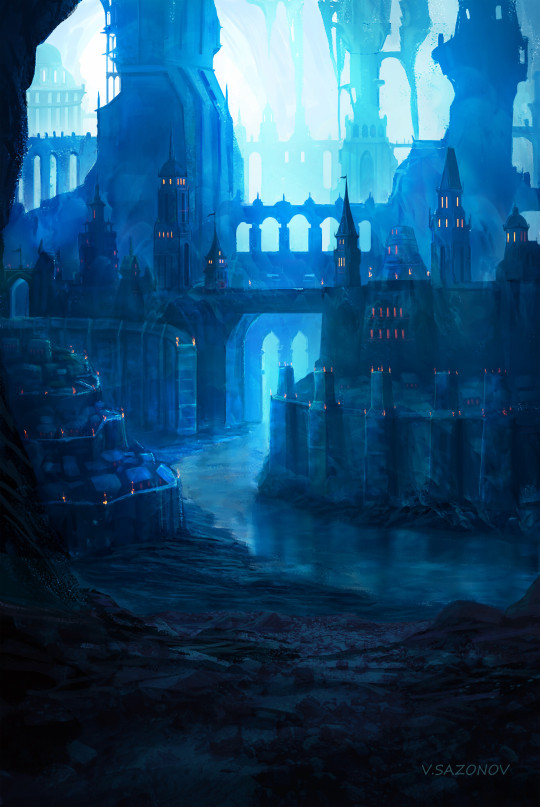
A different flavour of Darkelf
Artsource
Anyone who's played eldenring knows that the subterrnaian stretches of the map are some of the coolest regions ever created for the franchise: ancient cities built into the walls of caverns vast beyond imagining, all lit by an eerie phosphorescence that one could easily mistake for innumerable stars. There are many creatures the underground, from priests of melted clay to shamanistic hulks that revere the budding of horns.... but most interesting to us today are the Nox, secretive worshipers of the night sky banished beneath the earth.
I couldn't help but be struck by how cool the Nox were, and how great they'd be as an alternative take on drow, still maintaining some of the darkelf hallmarks but providing a lot of fresh elements. Now, I'vealready posted my general take on the drow, but since I'm doing a 'soulslike roleplaying' project at the moment ya'll are going to have to indulge me as I've got Elden ring on the brain.
Here's some random Nox lore for you to pilfer for your own campaign:
The Nox once lived on the surface world and worshipped the moon, stars, and night sky, but were forced underground when a new order emerged and declared them heretics for failing to bend the knee. This was not a slow process: when challenged the Nox invented a weapon that could kill the destiny controlling god of their enemy and in retribution that enemy smote their cities underground by divine edict. The surviving Nox were rightly pissed about this and have been working through the ages to take their revenge.
You can tell you're in Nox territory because of the false night sky decorating the cavern ceilings, such is their love for the stars. Their culture is theocratic and matriarchal, dedicated to preserving the rites and traditions of their once great era. Much of their teachings are based around waiting for a so called "lord of night" one who will bring about their promised return to the surface and an end to their exile. Sadly because their enemy controls fate and has halted the progression of the stars, this lord will never arrive to overturn the status quo, leaving the Nox in theological limbo.
One of the many mystical traditions guarded by the Nox is the creation of life through the manipulation of alchemical quicksilver, primarily a servant species known as the albinorics. These homonculi come in different shapes but are consigned to much of the drugework in Nox territory, and are reliant on their creators to keep their bodies from degrading. One faction of the Nox have even attempted to create their supposed night lord through the use of this silver tear alchemy, and if that doesn't strike you as a fasinating questhook I don't know what will.
Another of the silverwrought gifts of Nox alchemy is to be reborn in a new shape, a trick most Nox use to prolong their lifespans through the ages but some utilize as a means of infiltration, detectable only by the fact that those who are reborn bleed silver. This of course only adds to the surface dweller's paranoia over the Nox, of whom they only usually encounter wandering alchemists, strange mystics, and plotting assassins.
84 notes
·
View notes
Text
I aspire to worldbuild in such a way that geologists don't look at the map and complain how it doesn't make sense, but such that geologists look at the map and go "wait, what the fuck happened there??"
reminder to worldbuilders: don't get caught up in things that aren't important to the story you're writing, like plot and characters! instead, try to focus on what readers actually care about: detailed plate tectonics
141K notes
·
View notes
Text
Why Play Dieselpunk 1921? Character Options
Inspired by @anim-ttrpgs, I thought I'd make a lil' series about why you should play Dieselpunk 1921!
Dieselpunk 1921 has no classes, which means you aren't locked into a specific play style that you might not like in the end. Professionals are given a choice from a wide variety of Occupations, all of which provide some sort of bonus to your skills, and Backgrounds, which give you bonus tools and faction interactions.
The options range wildly, from Great War Veteran Spies infiltrating the highest ranks of the burgeoning Criminal Underworld, to Long Term Convicts turned Union Organizers leading their fellow workers against Mine Owners and Private Detectives in the United States. The options are (nearly) endless, but my favourite character that I've made is Wessel Hörst van Wieren, a Noble Scion/Great War Veteran turned criminal after deserting from the Austrian army.
Whether you want to run a tense noir game in the shadowy streets of New York, a Daring heist in the busy city of Tokyo, or a tale of love and loss in Brasilia, Dieselpunk 1921 gives you the tools and options you need to make whatever character you want!
Check out Dieselpunk 1921 here!
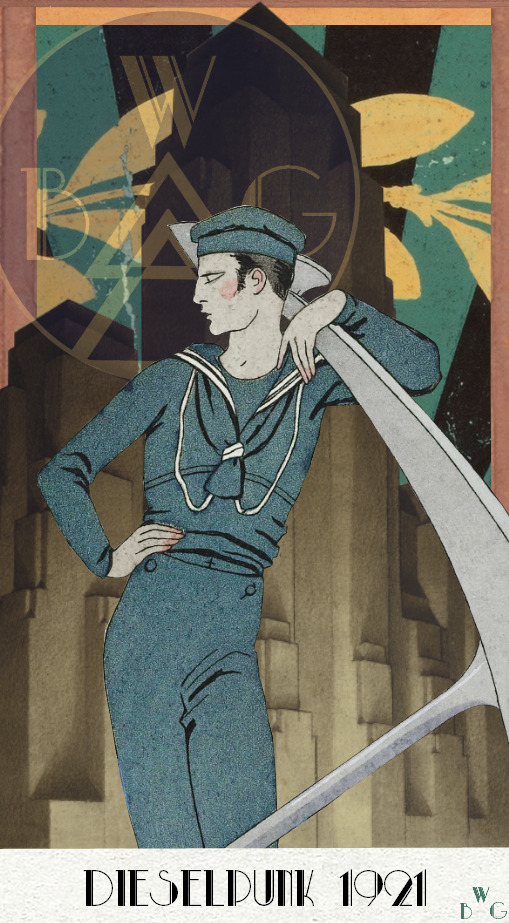
#indie ttrpg#ttrpg#ttrpg community#ttrpg design#tabletop rpg#ttrpg art#dieselpunk#indie games#indie rpg#worldbuilding#indie rp#indie game#tabletop roleplaying#tabletop gaming#tabletop#roleplaying games
58 notes
·
View notes
Text
When an adventuring party goes through a dungeon it has horrifying consequences on the local ecology. From the perspective of a naturalist or an anthropologist the average adventuring party safely escaping a dungeon is the equivalent of a small natural disaster, often acting as a wound that the ecosystem may never fully recover from. Looking here at a dungeon that's just been 'completed'.
The local town has a major influx of gold from an adventuring party spending a few nights there. The innkeeper and blacksmith have both gotten more money than either of them could have overwise made in years. The local lord will come through here in a few days and falsely accuse both of them of treason so that he can take their possessions, and the town's economy will return to normal. The innkeeper and blacksmith with be banished, their sons conscripted into the war effort, and their daughters doomed to poverty, but what matters to the lord is the gold. The adventurers will never know.
The hydra guarding the dungeon who was killed was the alpha in the area. Countless male hydras will fight to take his place, most of them younger, their species' territory is shrinking due to the expansion of humans in this area, this gate and this marshland is one of the last good areas for hydras to nest in the valley left. Male hydras are the ones to take care of the young after they hatch, the ones taken care of by the hydra the adventurers killed were too young to compete with the hydras coming in to take his place, some will run off into the woods and die when the winter comes, most will be cannibalized by the males coming to replace their father.
The dungeon was a rare example of untouched ruins. It had art and artifacts that can never be replaced. Every "puzzle" that was "solved" and every pillar and carving that the adventuring party destroyed in a fight is an example of something lost that will never be replaced. Anthropology's understanding of the culture will forever be smaller. The "treasure" that the adventurers found is a bit better off, but most of it will forever be stripped of important context, even if any of it is studied one day elements of its origins will be forever lost, not to mention to many magic items that will very likely be destroyed in battle with the adventurers that stole them.
The mimics that were killed were an endangered species. They weren't common mimics, not that the adventurers know the difference. Those mimics were some of the only things capable of eating slimes, an invasive species in the area. The local town will have an infestation of slimes in a few years, and nobody will have any understanding as to why. They might even hire another adventuring party to deal with it. Luckily the adventuring party that went through this dungeon was able to kill a nominal amount of slimes, but this valley has far more slimes than it does mimics, and slimes breed far far faster.
The demon the adventuring party killed at the end of the dungeon was a servant of the brass goddess, sworn to protect the arts of a people long forgotten. Upon his defeat he will respawn in the underworld and finally reunite with the people who summoned him two thousand years ago. With one less sacred place of the old gods in this land, the conquest of the hanged king grows stronger, and an apocalyptic event that will bring this continent under his power a thousand years from now is ever so slightly more likely. The adventurers understood none of this of course, they don't care to know where the things who fight them come from, and one member of their party was a priest of the hanged king anyway.
The kobolds the adventurers killed will be found by members of their village in the morning, when their families begin to realize that they didn't come home after a hunt. Their kind is small and often killed by humanity when it is convenient to them. If their bodies are found they will be burnt at the village center, and the entire community will mourn them. One of the bodies will never be found, as its skull was used as an adornment to one of the adventurer's armor. The kobold elders will assure the children that those who are lost have returned to the great dragon below the earth, in a land where meat is plentiful, and humans never tread. The village will wonder if it can survive the coming winter, with less and less places to hunt every year, and more and more souls taken by human hands.
The adventurers will come to another town soon, and the wave of destruction will strike another part of the valley.
#196#worldbuilding#my worldbuilding#writing#my writing#fantasy#short fiction#short story#flash fiction#dark fantasy#original fiction#fantasy writing#original story#kobolds#hydra#mimic#slimes#demon#creative writing#writers on tumblr#writeblr#writers and poets#writers#writer
80 notes
·
View notes
Text
copying the rest before NaNo deletes its blog and Tumblr:
Meal Scenes for Worldbuilding
If we’re using food for worldbuilding purposes, does that mean we can say we’re worldcooking?
Just kidding! Worldbuilding, especially in historical fiction, science fiction, and fantasy, is an integral part of what you must do as a writer (In truth, it’s also important for writers from other genres, but we’re specializing in these three today).
Meal scenes can be an important part of the worldbuilding process. Food is intrinsically tied to a culture or a country, or even a small region. That’s why it’s important, when building your own world, to take time to figure out the bare minimum of what your characters will be eating.
Let’s do an example. Your world is fantasy, your kingdom set beside a wide river. Perhaps your capital city, where much of the action is located, is surrounded by wetland.
If this is the case, what types of food would likely grow there? Seafood, fished from the large river, might be your characters’ staple proteins, while rice might grow better than another grain because of your kingdom’s wetlands. Fruit, perhaps even coconuts, might be the sweet stuff your main character loves to devour.
Remember that your world directly affects what types of food your characters will be having: is there coffee in space? What about in Byzantine Turkey or your new riverside kingdom?
Shannon Chakraborty does a phenomenal job with this in her fantasy series The Daevabad Trilogy, which is set in the eighteenth century across the Middle East. Her first book, The City of Brass, is especially good at showcasing the often-fragrant dishes of the various cultures across this region of the world (some copies of the book even have a short list of recipes from the book that foodies can try whipping up for themselves).
While her book is set within the fantastical world of the Djinn, her food is based upon recipes that have been preserved for centuries.
There’s one small reminder with all of this: it’s important not to get too caught up in describing each dish so much that you end up taking the focus away from the characters in a meal scene. Meal scenes can be breaks from fast action, but they should also continue the plot.
Meal Scenes for Developing Characters & Relationships
Character development can be hard, especially if you have a handful of characters that you love! But in order to make your readers love them too, you have to show them interacting with the world around them.
That guy we love to hate? Maybe he’s a loner who has grown up eating by himself. Having him forced to sit and eat with a group of people who have known each other for years might be an awkward moment for him, but it helps readers to learn more about his own worldview — and it might just help get him out of his shell, or at least off the love-to-hate list.
Besides helping you develop a single character, writing meal scenes with some of your characters can also help readers learn more about the relationship between your characters.
Let’s say you have your main character, MC. MC leans over and steals a French fry from her best friend. There’s no issue, right? That’s because they like each other, and the best friend has likely eaten with MC before, and knows she enjoys stealing food from other people’s plates.
But when MC tries it again, this time with the guy sitting next to her, he whacks her hand to stop her from stealing. This sparks an argument that seems, at least to everyone else watching it, pointless, but readers will know from the rest of the story that they’re the enemies-to-lovers trope. This argument is just one of many before they finally acknowledge their feelings towards one another.
See how that worked? A meal scene wasn’t useless; it pulled the story along by giving readers another taste of the enemies-to-lovers trope that so many enjoy reading.
If you need a more visible example of how this can play out, try watching a movie like Pride & Prejudice, (the book is amazing, but I’m suggesting the movie as a visual aid). The movie does a great job showcasing just how different the members of the Bennet family are individually, how they act around each other, and how they act around company.
There’s often little action in meal scenes, so they’re not meant to be overused. The plot should also still be there — take the cringey proposal scene between Mr. Collins and Elizabeth in Pride & Prejudice, for example, which follows directly after a meal when the rest of her family abandons her. In this case, the plot (and Mr. Collins’ advances) ruin her meal.
Perhaps your meal scene is the much-needed respite in between battling fierce aliens for planet Earth, or the first time your main character’s enemy-to-lover has entered her home. Either way, meal scenes are an important way to immerse your readers in what kind of world they’re imagining as well as showcasing how your characters act and — more importantly — how they act around each other.

Lacey Pfalz is a travel journalist by day, hopeful author by night. She belongs to the class of graduates she dubs the Class of COVID-19, having graduated with a double major in history and writing at Wisconsin Lutheran College in 2020. Her writing passions include fantasy, science fiction and historical fiction (with a little bit of romance, of course!). As someone with a physical disability, it’s her dream to write a fantasy series featuring a main character like her. Header Image by Jack Sparrow
How to Use Meal Scenes to Develop Characters, Relationships, and Your World

Worldbuilding can sound complicated, but why not make it a little more simple by focusing on food? It may be the domestic touch you need! NaNo Participant Lacey Pfalz talks about using meal scenes to develop your world and your characters.
There’s one thing that remains a universal human truth: we love food! While our perspectives on food might differ, people all across the globe gather together during mealtimes — and thus, mealtimes are made memorable.
Meal scenes can also help your story in a few key ways, especially if it’s fantasy, science fiction or historical fiction.
Keep reading
1K notes
·
View notes
Text


Queen Hippolyta and her cartcow - Kastanox
38 notes
·
View notes
Text

Dwarven Huntress
#artwork#digital illustration#digital art#medieval art#fantasy art#worldbuilding#ned the knight#original art#artists on tumblr#dwarf#dnd#character design#original character
32 notes
·
View notes
Text
From Under the Cut
Marshy Garfinch- These are barely flighted predators who specialize in wetlands and floodplains. They are more comfortable in the ground and water than flying, but to escape danger they can fly for short bursts. Very chill, will wait patiently for bycatch.
Common Coast Wyvern- Most populous kind, basically a large seagull. They are notoriously bold and fearless, which leads to them stealing food from much larger animals. Most of the time this works out.
Blushing Snapper- Sea going wyverns with a bad temperament. They're known for shrieking and snapping viciously, but tending to flee immediately at the first sign of a physical confrontation.
Pelizard- Basically a lil pelican. They like to bound around the numerous islands around Mirum scooping up fish. On the ground they struggle to walk so they end up hopping along most the time.
Sneck- Another marshland wyvern. One who has completely lost the power of flight. Mostly aquatic they spend pretty much their whole life hiding at the bottom of lake and river beds. Will stick their whole head and neck out to look around.
Galunk- Named for the sound the males make to woo the ladies, these fellas spend most of their time roaming around grasslands. They prefer going after small terrestrial prey which is easy as they are the fastest wyvern on the ground.
Pendulo- Basically a lil hummingbird. They spend their days drinking nectar and catching bugs at breakneck speed. Then at night they sleep by biting and dangling off tree branches. Goofy lil guys.
Rain Chaser- One of the largest wyverns, these guys spend most of the year away at oceanic islands and only return to the mainland during the rainy season. There they like to snack on woodworm eggs for a couple months to fatten up.
False Wyvern- This ones actually a bird.

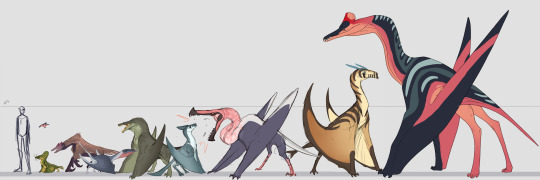
Some species of Mirum Wyverns! Wanted to get a broad grouping because they're very diverse.
Marshy Garfinch- These are barely flighted predators who specialize in wetlands and floodplains. They are more comfortable in the ground and water than flying, but to escape danger they can fly for short bursts. Very chill, will wait patiently for bycatch.
Common Coast Wyvern- Most populous kind, basically a large seagull. They are notoriously bold and fearless, which leads to them stealing food from much larger animals. Most of the time this works out.
Blushing Snapper- Sea going wyverns with a bad temperament. They're known for shrieking and snapping viciously, but tending to flee immediately at the first sign of a physical confrontation.
Pelizard- Basically a lil pelican. They like to bound around the numerous islands around Mirum scooping up fish. On the ground they struggle to walk so they end up hopping along most the time.
Sneck- Another marshland wyvern. One who has completely lost the power of flight. Mostly aquatic they spend pretty much their whole life hiding at the bottom of lake and river beds. Will stick their whole head and neck out to look around.
Galunk- Named for the sound the males make to woo the ladies, these fellas spend most of their time roaming around grasslands. They prefer going after small terrestrial prey which is easy as they are the fastest wyvern on the ground.
Pendulo- Basically a lil hummingbird. They spend their days drinking nectar and catching bugs at breakneck speed. Then at night they sleep by biting and dangling off tree branches. Goofy lil guys.
Rain Chaser- One of the largest wyverns, these guys spend most of the year away at oceanic islands and only return to the mainland during the rainy season. There they like to snack on woodworm eggs for a couple months to fatten up.
False Wyvern- This ones actually a bird.
#keep reading posts#entelodante#mirum#speculative biology#spec bio#wyverns#worldbuilding#fantasy#no true north
934 notes
·
View notes
Text
The farther down you go, the simpler the ruins get. Our castles of cut stone and mortar stand atop our ancestors’ town of clay bricks, which was built on the earthen ramparts of their ancestors’ wooden hill fort.
Not all of the people who lived here left records. There were silent populations who lost the use of writing and had to spend a century inventing it again. But they always made their mark with tools or buildings or the things they threw away. The royal chronicler is working on a timeline of the groups who called this place home.
But nobody had ever seen ruins like those we found, working down through the deepest dungeon and clearing a collapsed shaft. Nobody had ever read the language on the cracked walls of smooth stone. It took all our priests, historians, and clerks to interpret it - the words had common roots with some of our languages, and the pictures helped. What it said… well, the Queen had the most succinct response: “Why would anyone choose to build here, if they read that?” After all, this is not a place of honor.
Idea: play Mutant Crawl Classics in a setting with some established towns and nations. What kind of cool cultures, economies, and politics can you develop in a world where people live with mysterious powers and dangerous creatures?
30 notes
·
View notes